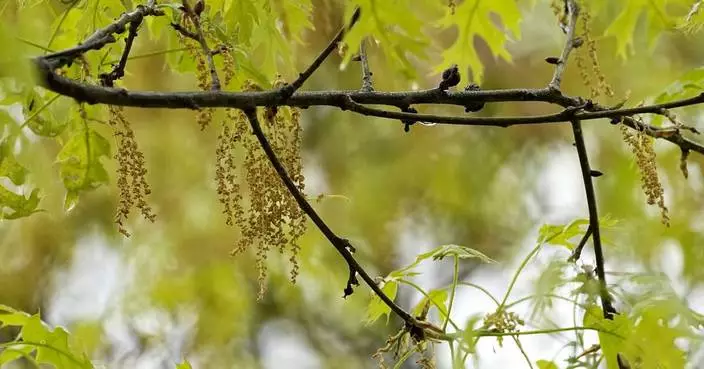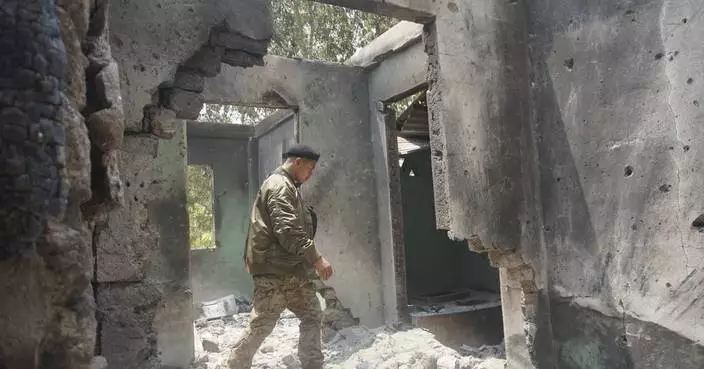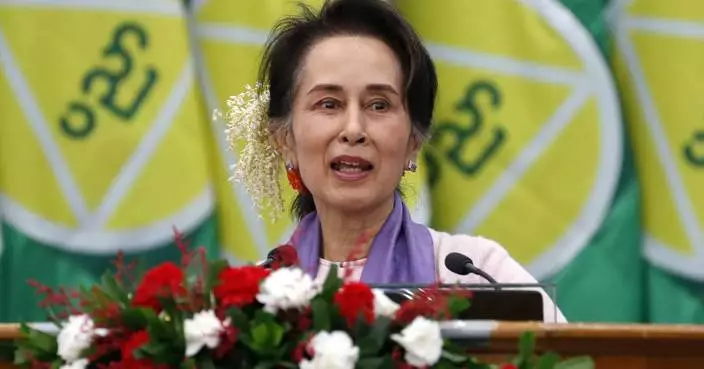Myanmar's army was not the only group that slaughtered civilians in the country's volatile west last year, Amnesty International said in a new report accusing ethnic Rohingya insurgents of massacring dozens of Hindus during an escalation of a long-running communal conflict in Rakhine state.
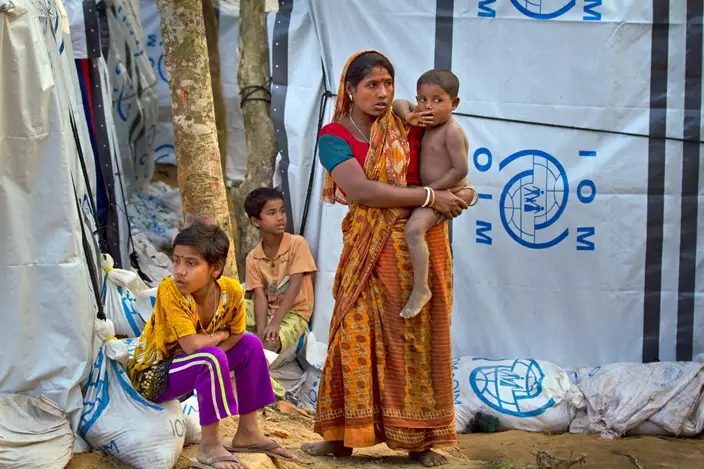
FILE - In this Jan. 16, 2018, file photo, a Hindu refugee stands outside her makeshift shelter with her children, near Kutupalong refugee camp near Cox’s Bazaar, Bangladesh. (AP Photo/Manish Swarup, File)
The London-based rights organization said it had investigated the widely reported killing of dozens of minority Hindus on Aug. 25 in a village called Ah Nauk Kha Maung Sei and concluded Rohingya militants were responsible.
Claims that the Arakan Rohingya Salvation Army, or ARSA, had carried out a massacre there were first made by the government and security forces just hours after it occurred. It was the same day Rohingya militants attacked 30 police posts and an army base in the volatile region, provoking a bloody army counter-offensive that eventually drove nearly 700,000 Rohingya civilians into Bangladesh.
At the time, Myanmar officials said they had discovered two mass graves containing dozens of bodies, and that around 100 Hindus were missing in all. The story, though, became controversial after survivors who reached Bangladesh gave conflicting testimony to reporters, with some blaming ethnic Rakhine Buddhist locals instead.
Amnesty International said the findings in its report released Wednesday were based on "a careful review of evidence" that included the testimony of dozens of people and imagery analyzed by forensic pathologists.
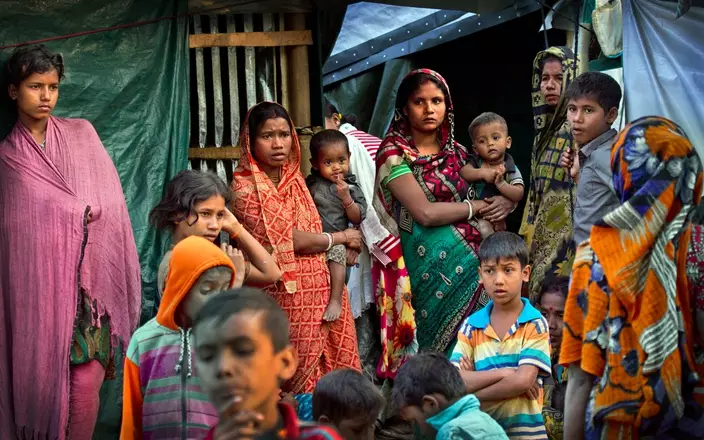
FILE - In this Jan. 16, 2018, file photo, Hindu refugees stand outside their make shift shelters at Kutupalong refugee camp near Cox's bazar, Bangladesh. (AP Photo/Manish Swarup, File)
"Our latest investigation on the ground sheds much-needed light on the largely under-reported human rights abuses by ARSA during northern Rakhine state's unspeakably dark recent history," said Tirana Hassan, the group's crisis response director.
"Accountability for these atrocities is every bit as crucial as it is for the crimes against humanity carried out by Myanmar's security forces," Hassan said.
While nobody knows for sure how many people were killed in Rakhine state since August — the government generally prohibits independent reporting from the area — the vast majority of those who died are believed to be Rohingya killed by security forces. The aid group Doctors Without Borders estimates at least 6,700 Rohingya were killed during the first month alone.
ARSA could not be reached for comment on the Amnesty International report. A once-active Twitter account attributed to the group has not tweeted since January.
In its report, Amnesty International said that Rohingya militants, clad in black and wielding guns and swords, attacked the Hindus in Ah Nauk Kha Maung Seik around 8 a.m. on Aug. 25.
It's unclear why, but some suspect the militants believed the Hindu community sympathized with the predominantly Buddhist government's anti-Rohingya stance.
Amnesty International said the fighters blindfolded their victims and marched them away before executing 53 of them, including men, women and children. When the army launched its ferocious counter-attack, many survivors ended up fleeing into Bangladesh along with the insurgents.
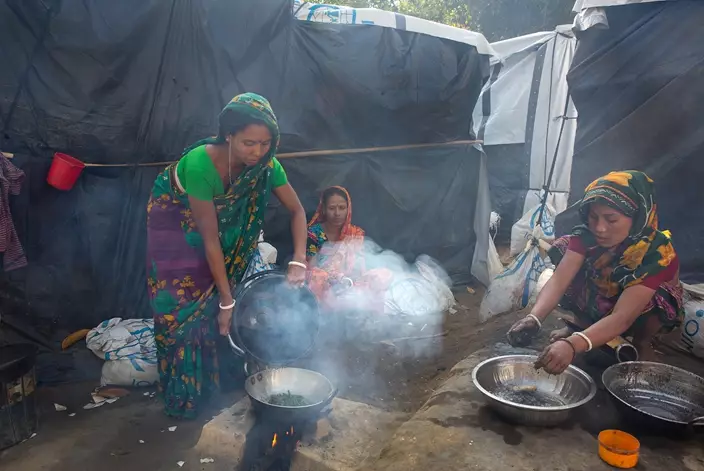
FILE - In this Jan. 19, 2018, file photo, Hindu women refugees prepare supper at their camp near Cox's Bazar, Bangladesh. (AP Photo/Manish Swarup, File)
There, ARSA members threatened witnesses and told them to say Rakhine villagers were responsible, Amnesty International said. After the survivors returned to Myanmar in October, however, they "unambiguously asserted that Rohingya, believed to be ARSA fighters, were responsible."
Amnesty International said the changing testimony was "largely explained by the pressures and threats to personal safety that they faced while in Bangladesh."
The group said it also based its determination on other evidence, including consistent descriptions witnesses gave of the attackers and forensic analysis of 31 photographs of exhumed bodies.
The group said 46 Hindus in the neighboring village of Ye Bauk Kyar disappeared the same day and are believed to have been killed. And on Aug. 26, it said ARSA fighters killed six Hindus in Myo Thu Gyi.
David Mathieson, a former human rights researcher who is now an independent analyst based in Myanmar, said the Amnesty International findings confirm reports of ARSA's brutality.
"That doesn't justify in anyway the government's massive response that drove out nearly 700,000 Rohingya. It doesn't excuse it at all, but it does put another layer of complexity into the violence over the past year," he said.
HINGLAJ, Pakistan (AP) — The ascent of steep mud volcanoes marks the start of Hindu pilgrims’ religious rituals in southwestern Pakistan.
They climb hundreds of stairs or clamber over rocks to reach the summit, tossing coconuts and rose petals into the shallow crater while seeking divine permission to visit Hinglaj Mata, an ancient cave temple that is the focus of their three-day worship.
The dramatic surroundings of Hingol National Park in Baluchistan province are the setting for Pakistan’s largest Hindu festival, Hinglaj Yatra, which started on Friday and ends on Sunday. Organizers say more than 100,000 Hindus are expected to participate.
Muslim-majority Pakistan is home to 4.4 million Hindus, just 2.14% of the population, and Hinglaj Mata is one of the few Hindu sites that continues to draw large numbers of pilgrims every year from across the country.
Muslims and Hindus generally live peacefully in Pakistan, from where most of the Hindus migrated to India when it was divided by British colonialists in 1947. But there have been attacks on Hindu temples in recent years as relations between the rivals remain tense.
Hindus believe Hinglaj Mata is one the places where the remains of Sati, the goddess of marital felicity and longevity, fell to earth after she ended her life.
Maharaj Gopal, the temple’s most senior cleric, explains why people flock to it.
“It is the most sacred pilgrimage in the Hindu religion,” said Gopal. “Whoever visits the temple and worships accordingly during these three days will have all of their sins forgiven.”
The journeys begin hundreds of kilometres (miles) away, mostly from neighbouring Sindh province. Hundreds of packed buses set off from cities like Hyderabad and Karachi, traveling along the Makran Coastal Highway that hugs Pakistan’s south and southwest.
But there’s scant parking and vehicular access to the holy sites, so many pilgrims disembark and complete their travel by walking over parched and rocky terrain, sometimes barefoot and carrying children or luggage.
It’s a few kilometres (miles) from the main road to the mud volcano and then, from there, almost 45 kilometres (25 miles) to Hinglaj Mata.
Winds buffet the desert-like conditions, churning up dust that whips the eyes, nose and mouth. The pilgrims’ festive cheer and brightly coloured apparel are a contrast to the arid landscape. Strong gusts distort people’s celebratory cries of “Jai mata di” and “Jai shiv shankar.”
Kanwal Kumar, 28, was visiting the temple for the first time with her husband. “We have yet to conceive a child after six years of marriage, so we are hopeful for help from the goddess,” she said. “We believe that no one returns empty-handed. All wishes are granted by Hinglaj Mata.”
The Hindu festival brings the Pakistani park to life. Hundreds of stalls spring up to sell snacks, drinks, jewellery, and clothing. Vats of hot food are prepared in the open air or thatched huts. Pilgrims purchase coconuts, sweetmeats, flowers, and incense for their ritualistic offerings.
Aloo Kumar, 55, wanted to express her gratitude to Lord Shiva, one of Hinduism’s three most important deities. “He blessed our family with a grandson,” Kumar said, gesturing toward the boy beside her cradling his baby sibling. “We prayed for a grandson during last year’s festival.”
Hinglaj Mata thrums with activity, even after dark. Fairy lights and other decorations adorn the shrine and pilgrims jostle for position in front of it, sometimes holding up babies so the deities can bless them. Stewards urge them to pay their respects and move along.
The park’s Hingol River provides Hindu pilgrims with the opportunity for ritual bathing, like the Ganges in India.
While there is no ban on Hindu worship in Pakistan, openly practising the faith is not routine as ties between India and Pakistan are broken. Their interactions are riddled with animosity and suspicion after having fought three wars, built up their armies and armed them with nuclear weapons.
Travel restrictions and hostile bureaucracies largely keep people from crossing the border for leisure, study and work, although the countries sometimes make exceptions for religious pilgrimages, usually for India’s Sikhs.
The decades of political hostility present a challenge for the minority Hindu community, as many in Pakistan equate Hindus with India. The reverse exists in India, where Muslims complain of discrimination.
Versimal Divani, the general-secretary of Hinglaj Mata, lamented that only Hindus in Pakistan can attend the festival.
“We can visit this temple in our beloved country whenever our heart desires,” said Divani. “But this is not the case for the rest of the world’s Hindus. I would like the Pakistani government to issue them visas so they can come here and take blessings with them. It’s good for people-to-people contact and it’s good for the economy too.”
Associated Press religion coverage receives support through the AP’s collaboration with The Conversation US, with funding from Lilly Endowment Inc. The AP is solely responsible for this content.
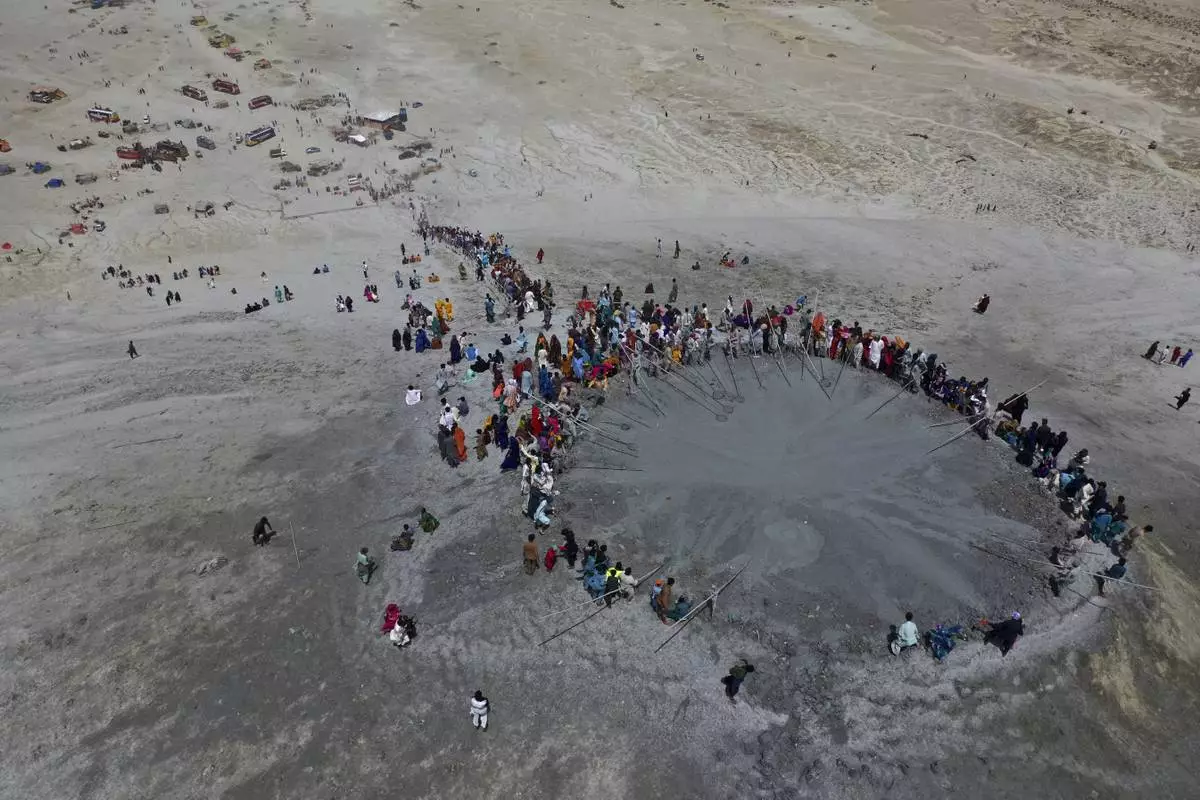
In this aerial photo taken from a drone, Hindu devotees climb stairs to reach on top of a mud volcano to start Hindu pilgrims religious' rituals for an annual festival in an ancient cave temple of Hinglaj Mata in Hinglaj in Lasbela district in Pakistan's southwestern Baluchistan province, Friday, April 26, 2024. More than 100,000 Hindus are expected to climb mud volcanoes and steep rocks in southwestern Pakistan as part of a three-day pilgrimage to one of the faith's holiest sites. (AP Photo/Mohammad Farooq)
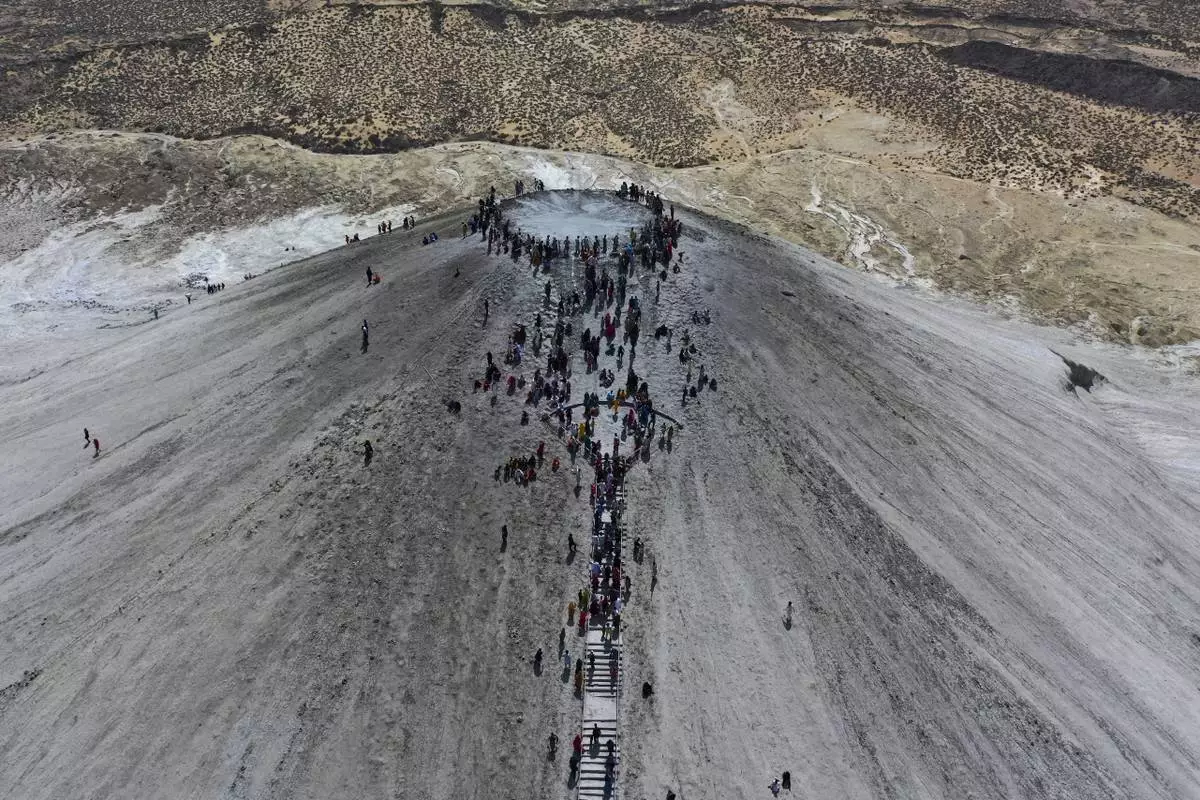
In this aerial photo taken from a drone, Hindu devotees climb stairs to reach on top of a mud volcano to start Hindu pilgrims religious' rituals for an annual festival in an ancient cave temple of Hinglaj Mata in Hinglaj in Lasbela district in Pakistan's southwestern Baluchistan province, Friday, April 26, 2024. More than 100,000 Hindus are expected to climb mud volcanoes and steep rocks in southwestern Pakistan as part of a three-day pilgrimage to one of the faith's holiest sites. (AP Photo/Mohammad Farooq)
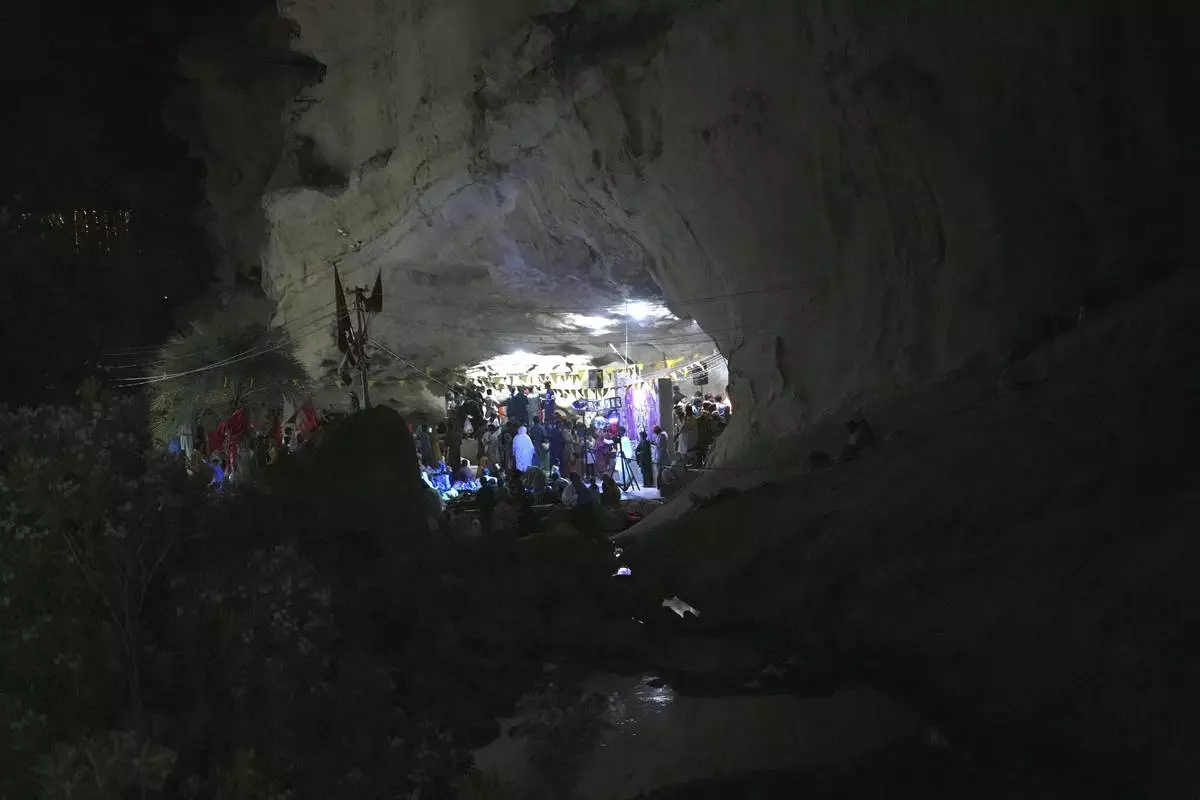
Hindu devotees attend an annual festival in an ancient cave temple of Hinglaj Mata in Hinglaj in Lasbela district in Pakistan's southwestern Baluchistan province, Friday, April 26, 2024. More than 100,000 Hindus are expected to climb mud volcanoes and steep rocks in southwestern Pakistan as part of a three-day pilgrimage to one of the faith's holiest sites. (AP Photo/Junaid Ahmed)
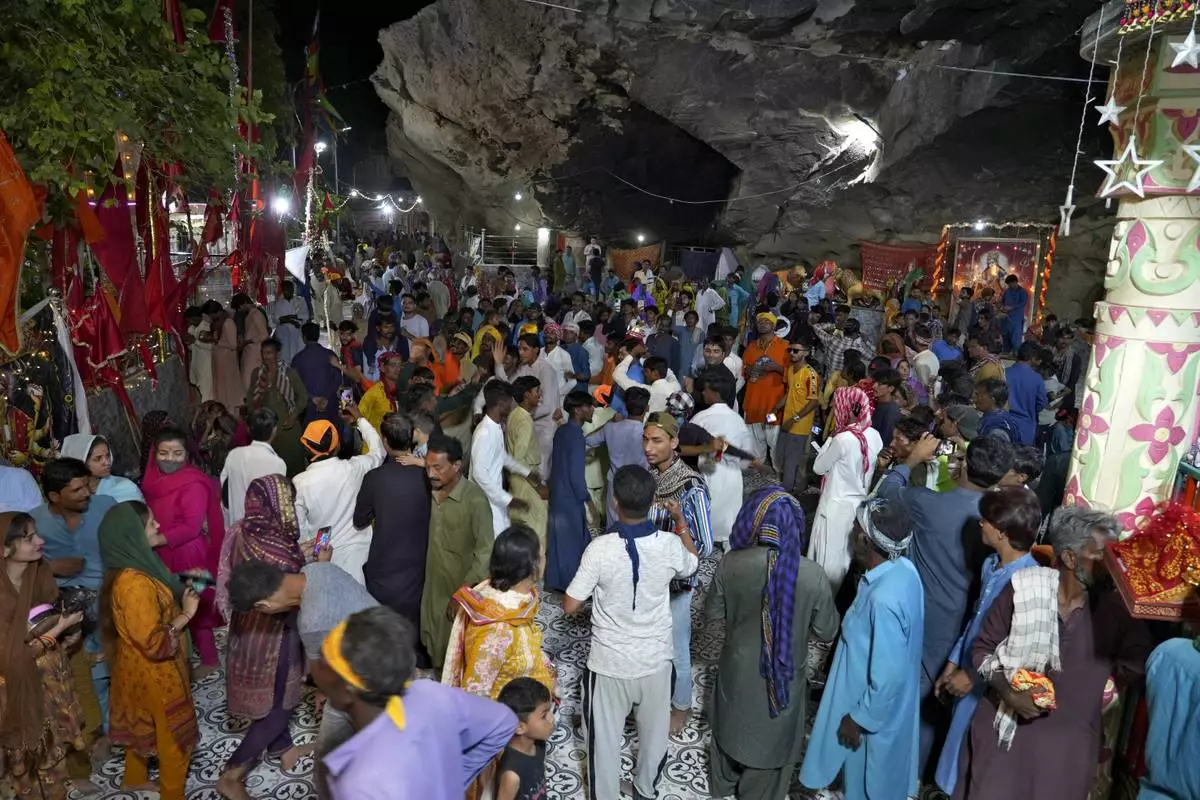
Hindu devotees attend an annual festival in an ancient cave temple of Hinglaj Mata in Hinglaj in Lasbela district in the Pakistan's southwestern Baluchistan province, Friday, April 26, 2024. More than 100,000 Hindus are expected to climb mud volcanoes and steep rocks in southwestern Pakistan as part of a three-day pilgrimage to one of the faith's holiest sites. (AP Photo/Junaid Ahmed)
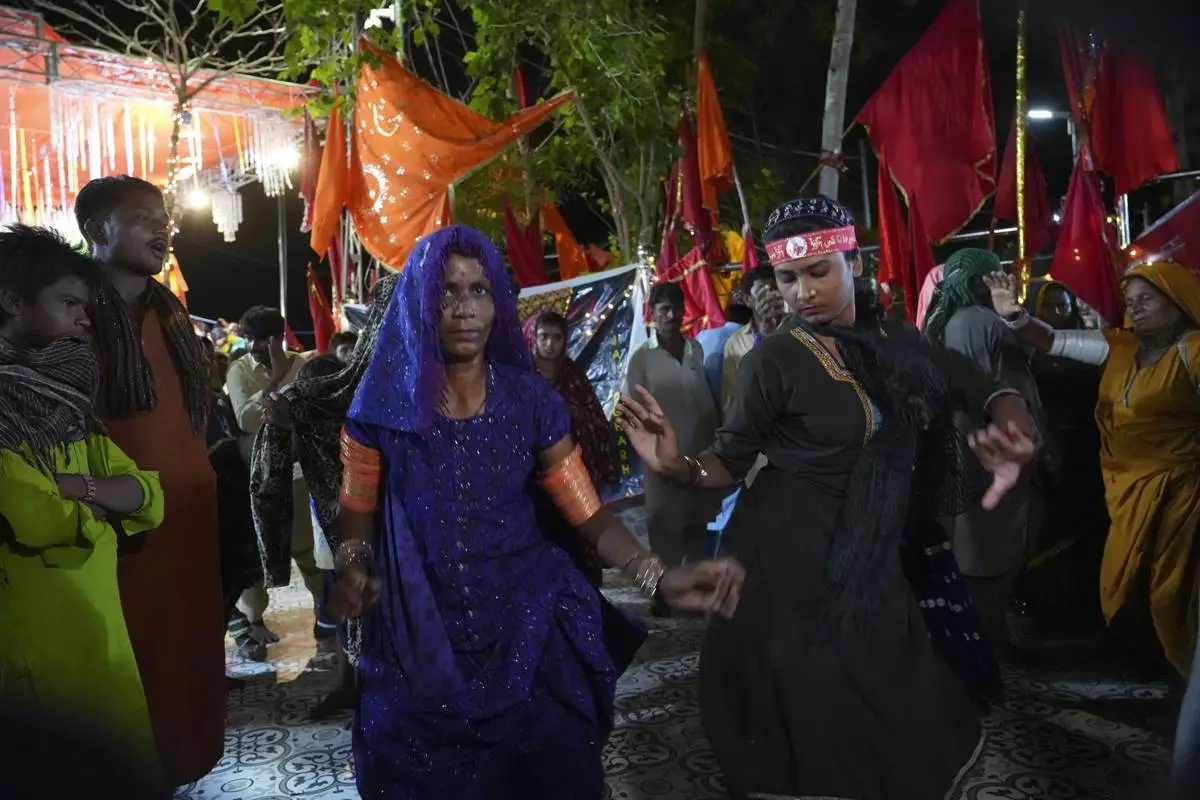
Hindu devotees dance during an annual festival in an cave temple of Hinglaj Mata in Hinglaj in Lasbela district in Pakistan's southwestern Baluchistan province, Friday, April 26, 2024. More than 100,000 Hindus are expected to climb mud volcanoes and steep rocks in southwestern Pakistan as part of a three-day pilgrimage to one of the faith's holiest sites. (AP Photo/Junaid Ahmed)

Hindu devotees perform their rituals during an annual festival in an ancient cave temple of Hinglaj Mata in Hinglaj in Lasbela district in Pakistan's southwestern Baluchistan province, Friday, April 26, 2024. More than 100,000 Hindus are expected to climb mud volcanoes and steep rocks in southwestern Pakistan as part of a three-day pilgrimage to one of the faith's holiest sites. (AP Photo/Junaid Ahmed)
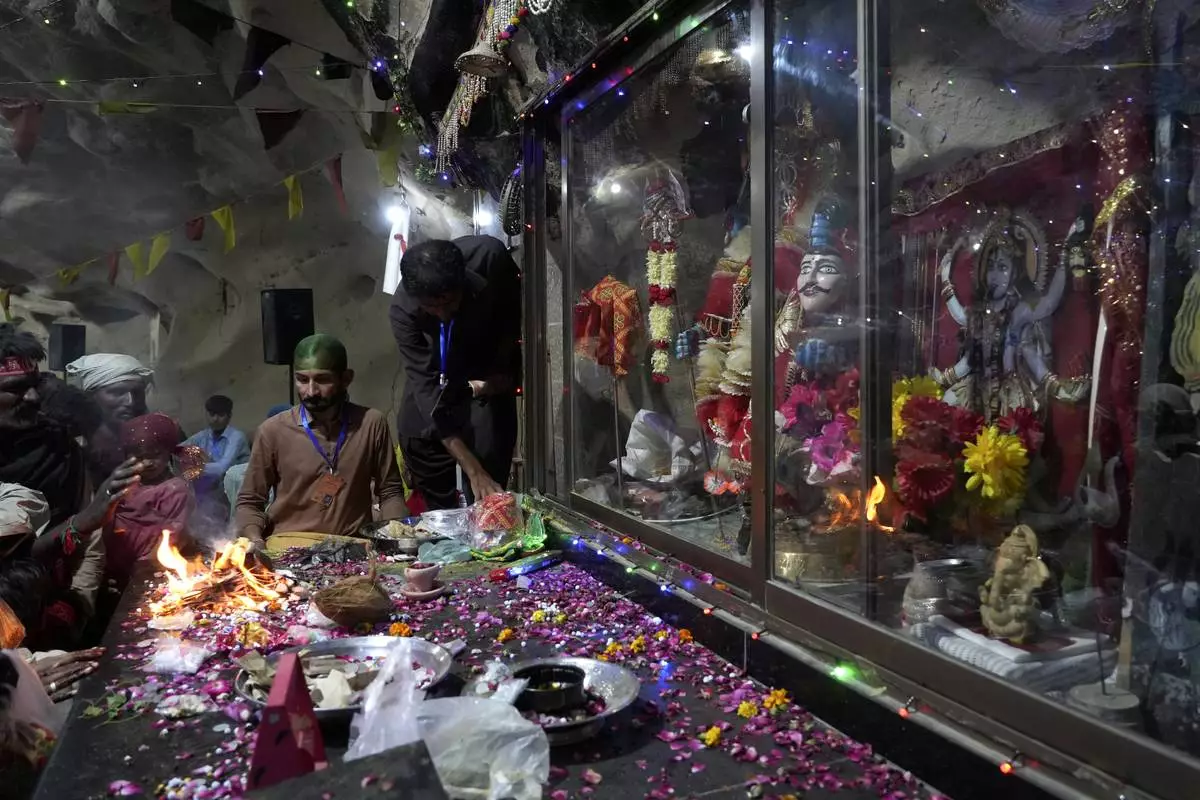
Hindu devotees perform their rituals during an annual festival in an ancient cave temple of Hinglaj Mata in Hinglaj in Lasbela district in Pakistan's southwestern Baluchistan province, Friday, April 26, 2024. More than 100,000 Hindus are expected to climb mud volcanoes and steep rocks in southwestern Pakistan as part of a three-day pilgrimage to one of the faith's holiest sites. (AP Photo/Junaid Ahmed)
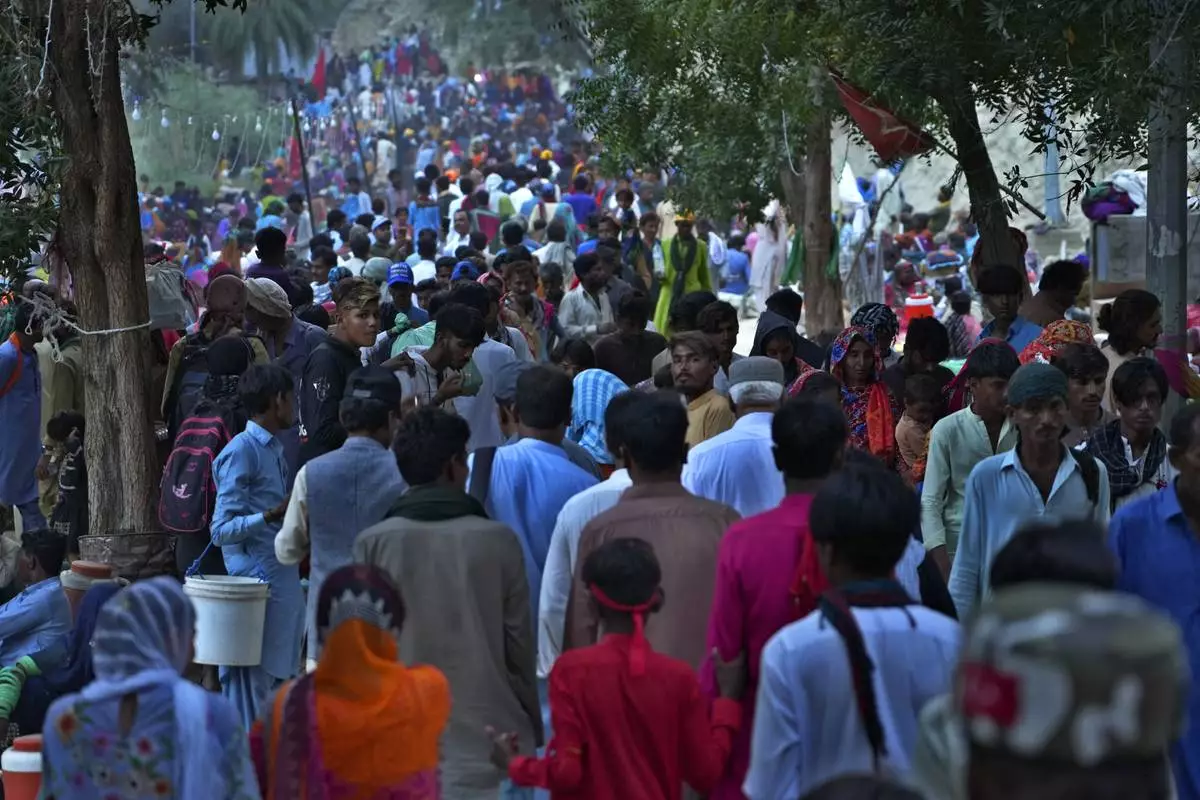
Hindu devotees arrive at an ancient cave temple of Hinglaj Mata to attend an annual festival in Hinglaj in Lasbela district in Pakistan's southwestern Baluchistan province, Friday, April 26, 2024. More than 100,000 Hindus are expected to climb mud volcanoes and steep rocks in southwestern Pakistan as part of a three-day pilgrimage to one of the faith's holiest sites. (AP Photo/Junaid Ahmed)
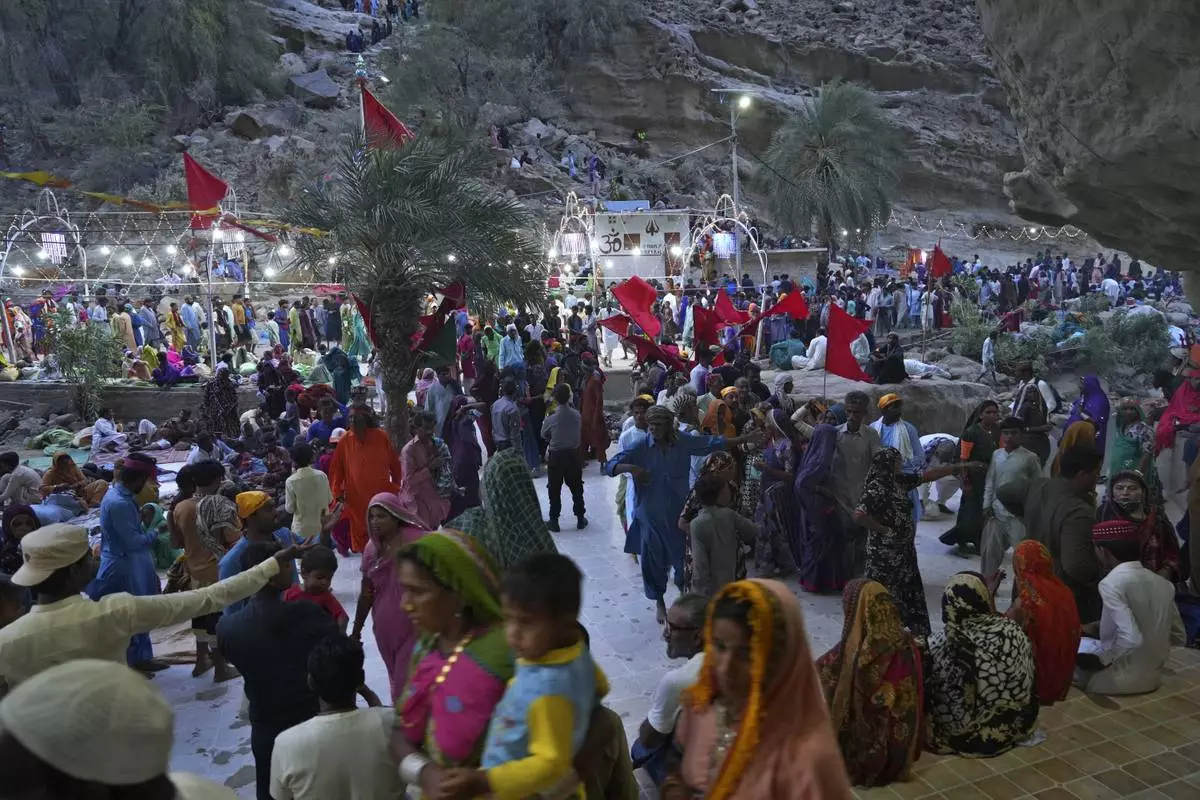
Hindu devotees arrive at an ancient cave temple of Hinglaj Mata to attend an annual festival in Hinglaj in Lasbela district in Pakistan's southwestern Baluchistan province, Friday, April 26, 2024. More than 100,000 Hindus are expected to climb mud volcanoes and steep rocks in southwestern Pakistan as part of a three-day pilgrimage to one of the faith's holiest sites. (AP Photo/Junaid Ahmed)
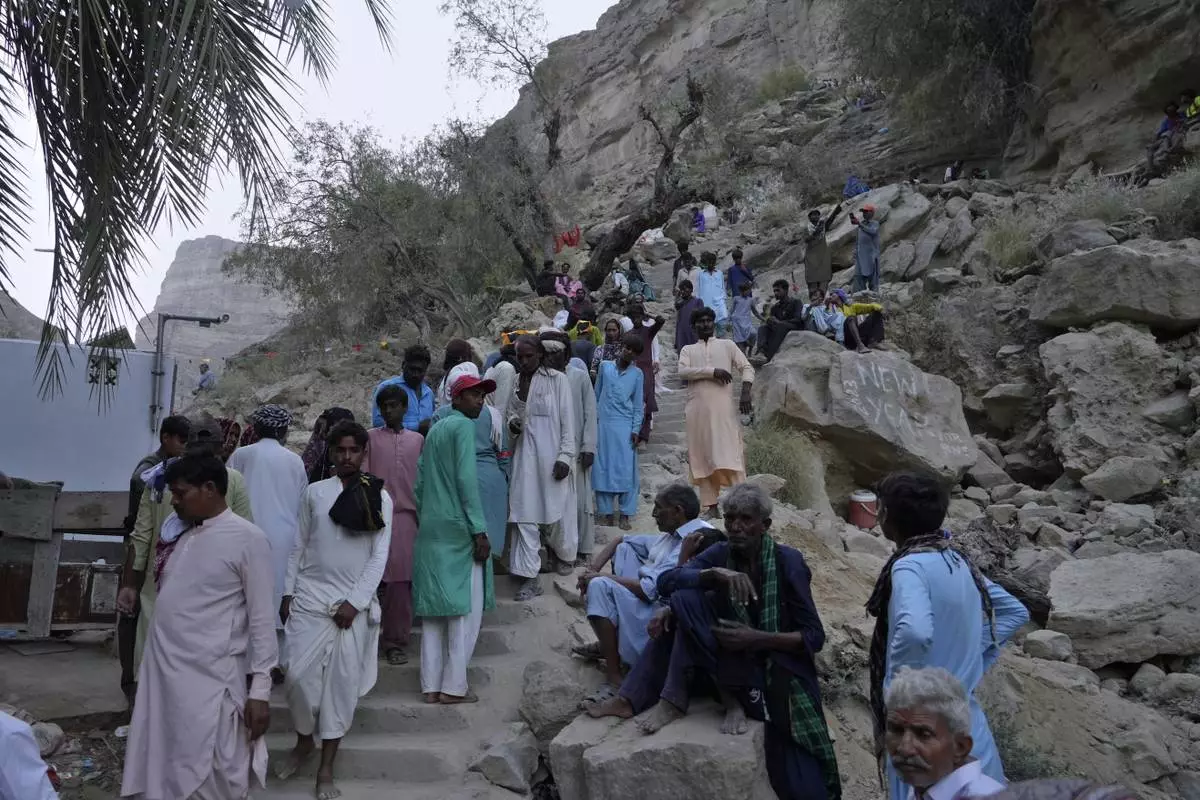
Hindu devotees climb stairs to reach atop an ancient cave temple of Hinglaj Mata to attend an annual festival in Hinglaj in Lasbela district in the Pakistan's southwestern Baluchistan province, Friday, April 26, 2024. More than 100,000 Hindus are expected to climb mud volcanoes and steep rocks in southwestern Pakistan as part of a three-day pilgrimage to one of the faith's holiest sites. (AP Photo/Junaid Ahmed)
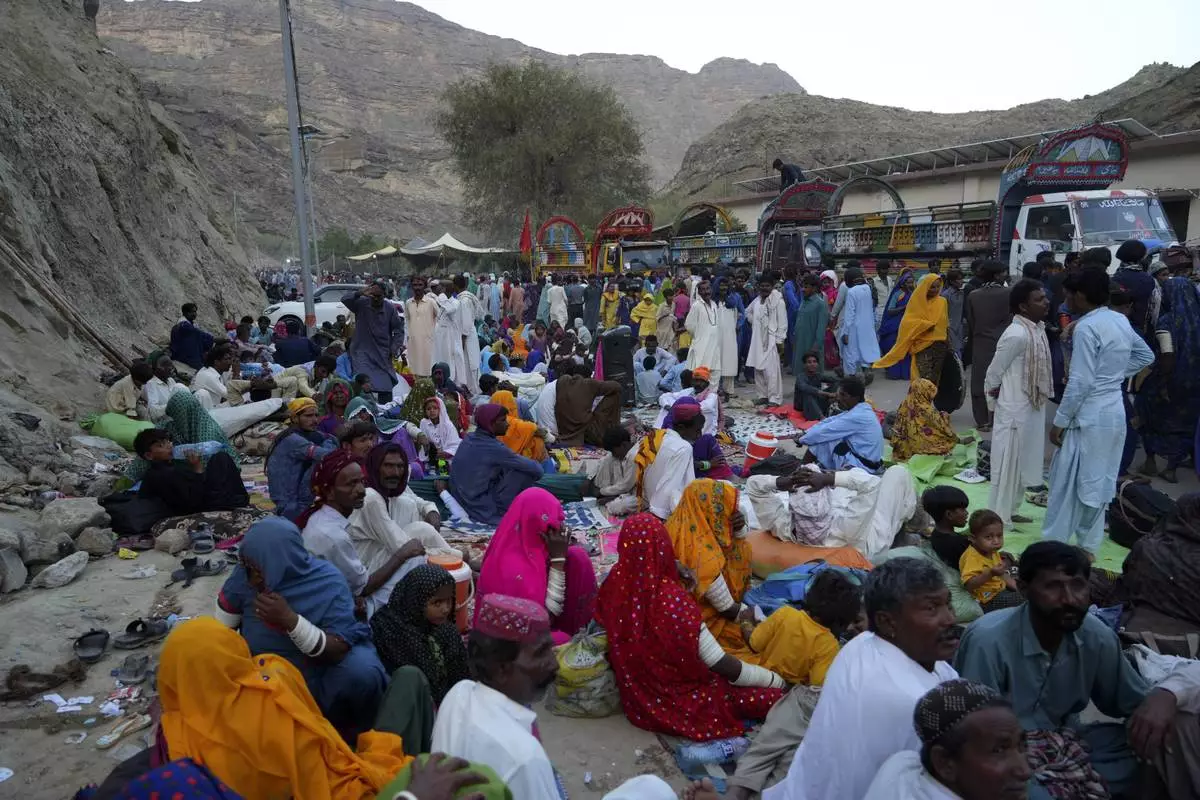
Hindu devotees take rest upon arrival at an ancient cave temple of Hinglaj Mata to attend an annual festival in Hinglaj in Lasbela district in the Pakistan's southwestern Baluchistan province, Friday, April 26, 2024. More than 100,000 Hindus are expected to climb mud volcanoes and steep rocks in southwestern Pakistan as part of a three-day pilgrimage to one of the faith's holiest sites. (AP Photo/Junaid Ahmed)
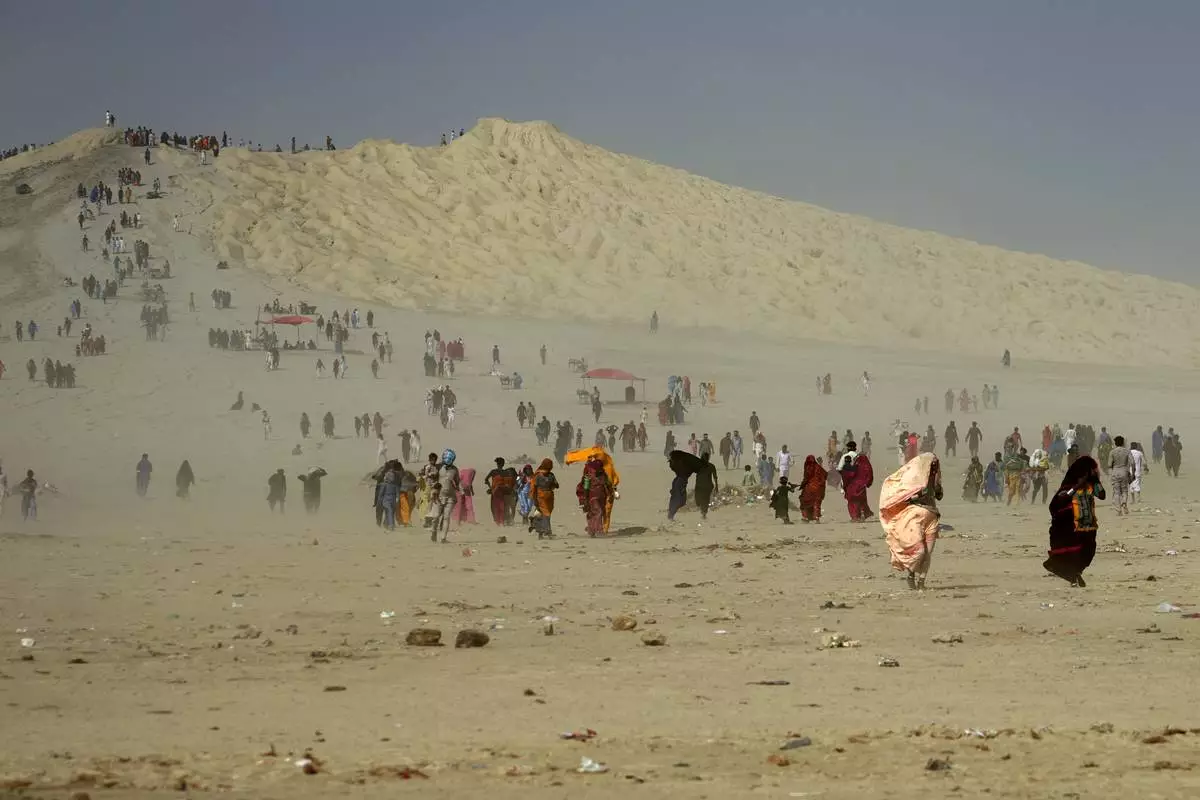
Hindu devotees walk toward a mud volcano, to start Hindu pilgrims' religious rituals for an annual festival in an ancient cave temple of Hinglaj Mata in Hinglaj in Lasbela district in the Pakistan's southwestern Baluchistan province, Friday, April 26, 2024. More than 100,000 Hindus are expected to climb mud volcanoes and steep rocks in southwestern Pakistan as part of a three-day pilgrimage to one of the faith's holiest sites. (AP Photo/Junaid Ahmed)
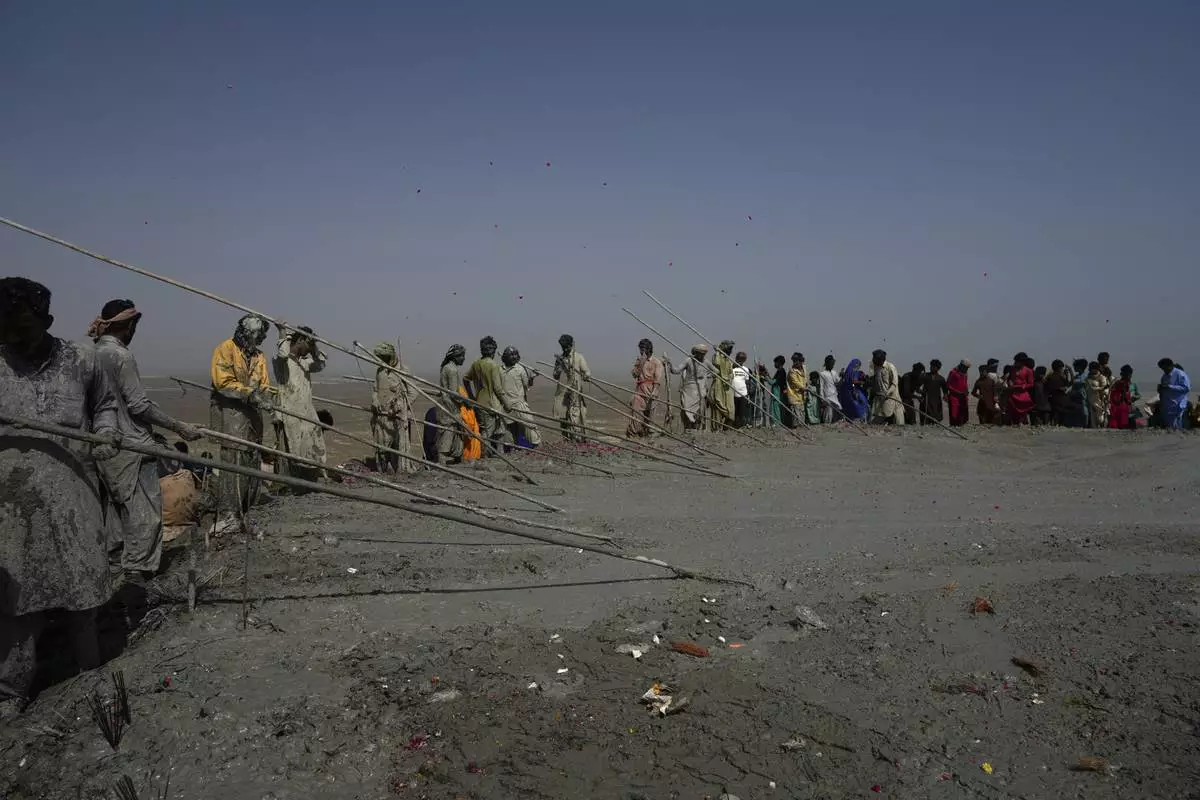
Hindu devotees perform their rituals on a mud volcano to start Hindu pilgrims' religious rituals for an annual festival in an ancient cave temple of Hinglaj Mata in Hinglaj in Lasbela district in the Pakistan's southwestern Baluchistan province, Friday, April 26, 2024. More than 100,000 Hindus are expected to climb mud volcanoes and steep rocks in southwestern Pakistan as part of a three-day pilgrimage to one of the faith's holiest sites. (AP Photo/Junaid Ahmed)
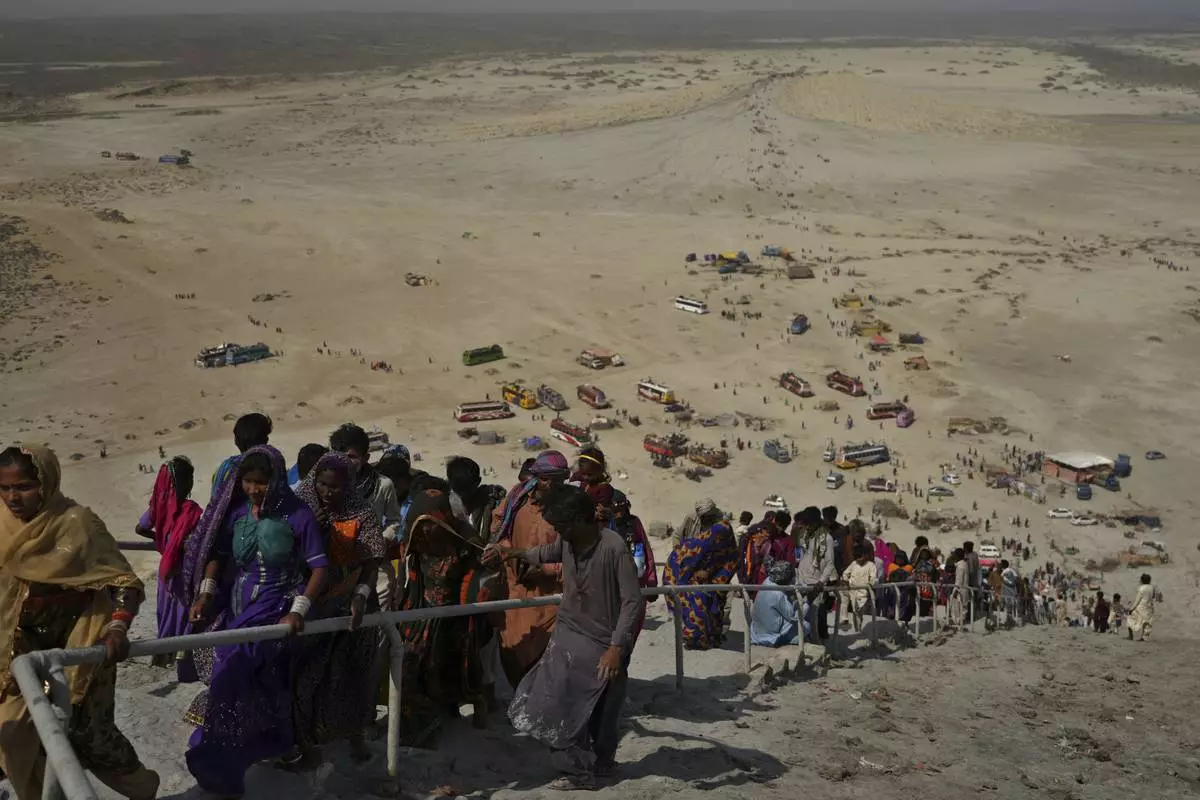
Hindu devotees climb stairs to reach atop a volcano to start Hindu pilgrims' religious rituals for an annual festival in an ancient cave temple of Hinglaj Mata in Hinglaj in Lasbela district in Pakistan's southwestern Baluchistan province, Friday, April 26, 2024. More than 100,000 Hindus are expected to climb mud volcanoes and steep rocks in southwestern Pakistan as part of a three-day pilgrimage to one of the faith's holiest sites. (AP Photo/Junaid Ahmed)
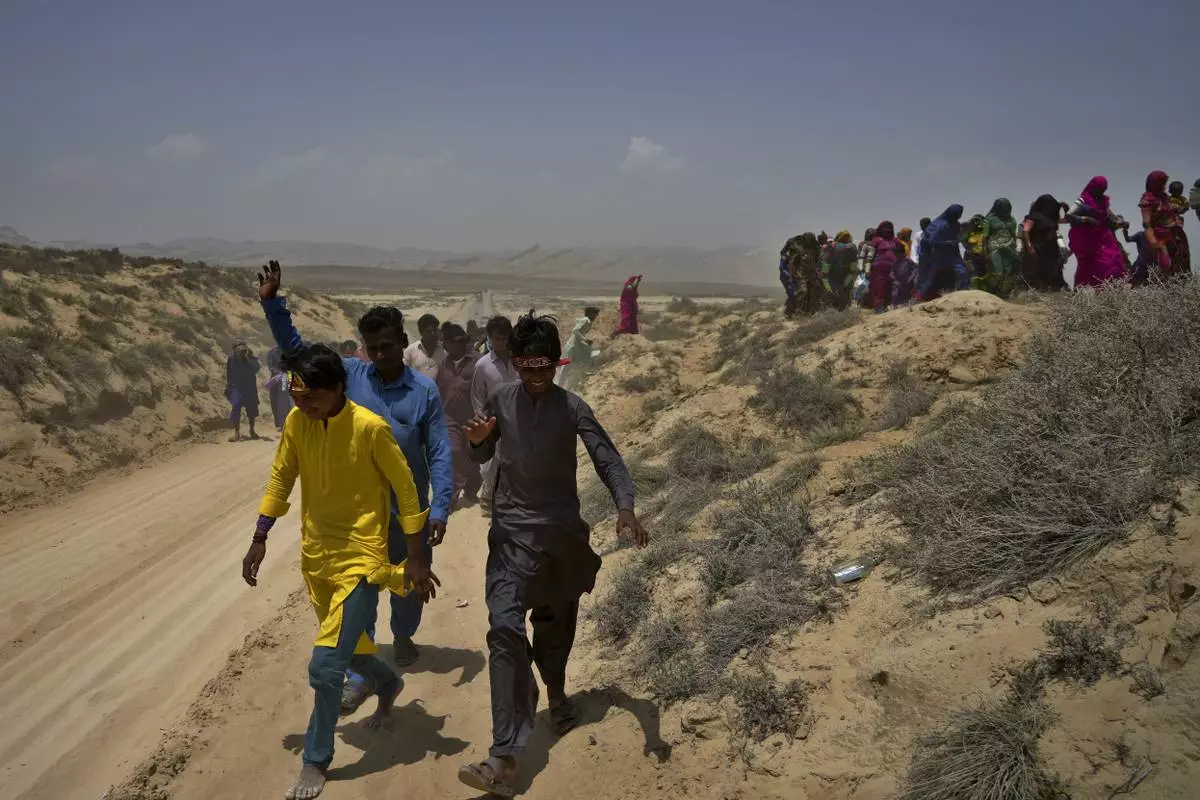
Hindu devotees walk toward a mud volcano to start Hindu pilgrims' religious rituals for an annual festival in an ancient cave temple of Hinglaj Mata in Hinglaj in Lasbela district in the Pakistan's southwestern Baluchistan province, Friday, April 26, 2024. More than 100,000 Hindus are expected to climb mud volcanoes and steep rocks in southwestern Pakistan as part of a three-day pilgrimage to one of the faith's holiest sites. (AP Photo/Junaid Ahmed)

Hindu devotees walk toward a mud volcano to start Hindu pilgrims' religious rituals for an annual festival in an ancient cave temple of Hinglaj Mata in Hinglaj in Lasbela district in the Pakistan's southwestern Baluchistan province, Friday, April 26, 2024. More than 100,000 Hindus are expected to climb mud volcanoes and steep rocks in southwestern Pakistan as part of a three-day pilgrimage to one of the faith's holiest sites. (AP Photo/Junaid Ahmed)
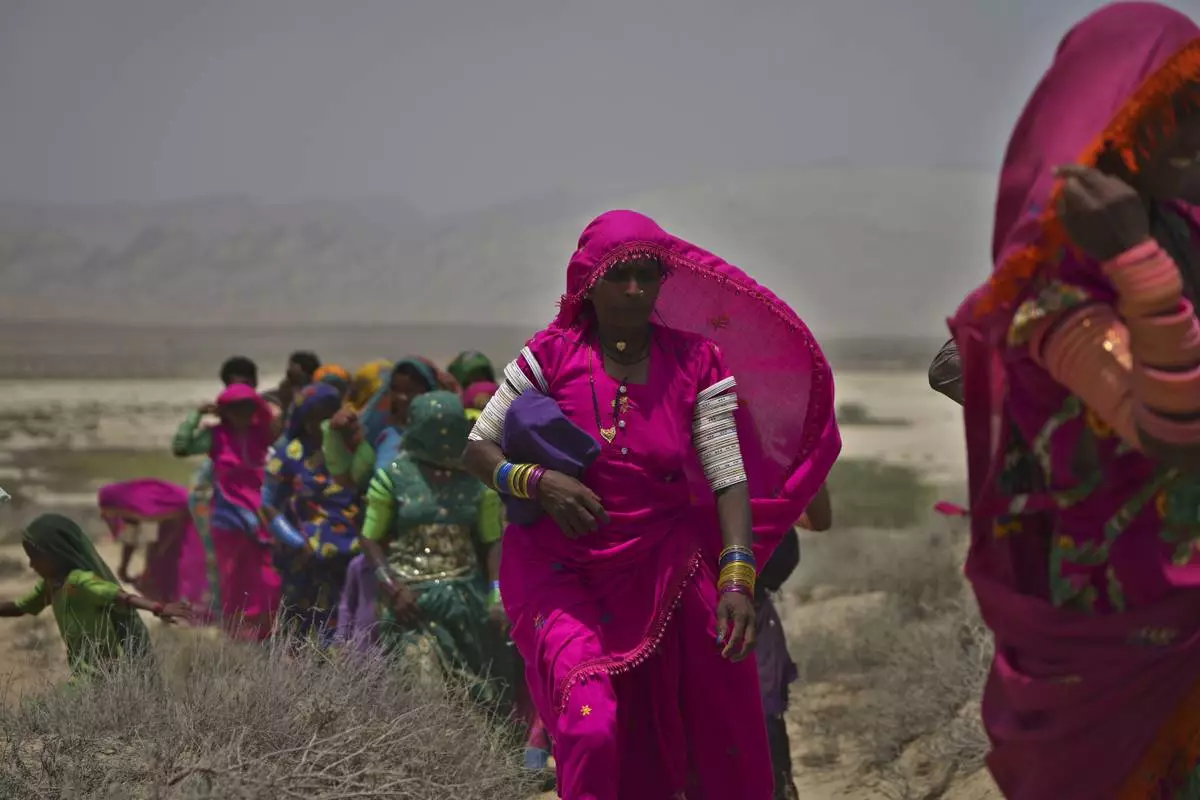
Hindu devotees walk toward a mud volcano to start Hindu pilgrims' religious rituals for an annual festival in an ancient cave temple of Hinglaj Mata in Hinglaj in Lasbela district in the Pakistan's southwestern Baluchistan province, Friday, April 26, 2024. More than 100,000 Hindus are expected to climb mud volcanoes and steep rocks in southwestern Pakistan as part of a three-day pilgrimage to one of the faith's holiest sites. (AP Photo/Junaid Ahmed)
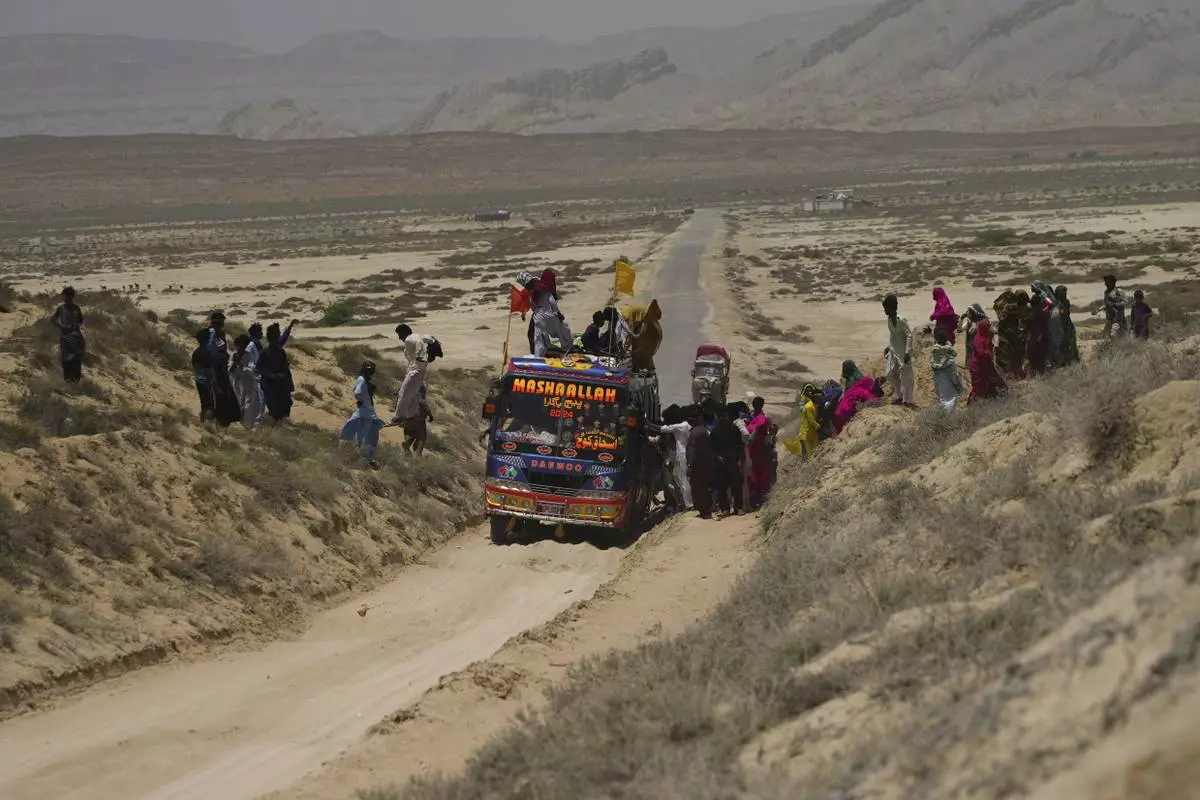
Hindu devotees get off from a bus and walk toward a mud volcano, to start Hindu pilgrims religious rituals for an annual festival in an ancient cave temple of Hinglaj Mata in Hinglaj in Lasbela district in the Pakistan's southwestern Baluchistan province, Friday, April 26, 2024. More than 100,000 Hindus are expected to climb mud volcanoes and steep rocks in southwestern Pakistan as part of a three-day pilgrimage to one of the faith's holiest sites. (AP Photo/Junaid Ahmed)
























